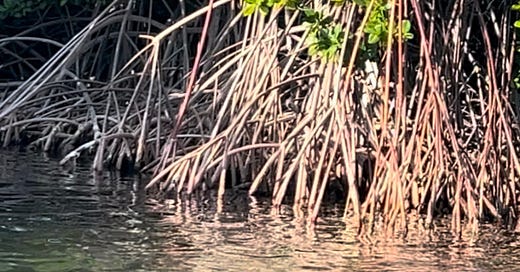Mangrove Forests
Yesterday we went on a mangrove tour with a local nonprofit, Mangrove Rangers and The Mangrove Action Project. They develop curriculum for all ages as well as implement restoration projects for mangroves and other coastal ecosystems including coral reefs and seagrass. Coral reefs get a lot of the attention, but all 3 of these environments work together and rely on one another to thrive, so we would not have healthy coral reefs if we don’t have healthy mangroves and seagrass ecosystems. Unfortunately, the biggest threat to mangroves here is property development, and in other locations things like shrimp farms and aquaculture. While tourism is an important part of the economy here on the Islands, mangroves do a lot to protect the island from storms and erosion, so quite literally this island could not exist without them. Also, the tourism is mostly based off of aquatic value like scuba diving, snorkeling, charter boats, etc. so it’s important to protect these habitats and ecosystems. Luckily, in 2016, the Cayman Islands began protecting the mangrove ecosystems and regulating developments.
So what is a Mangrove?
A mangrove is a shrub or tree that grows mainly in coastal saline or brackish water. Mangroves grow in an equatorial climate, typically along coastlines and tidal rivers. They have special adaptations to take in extra oxygen and to remove salt, which allow them to tolerate conditions that would kill most plants. Globally, there are over 70 types, but here on Grand Cayman there are 3 types: red, black, and white. The red are often called ‘walking trees’ because of their unique root structure and these ecosystems a myriad of different species. It’s estimated that up to 75% of all tropical fish are born in mangrove forests!
Ecosystem Services
These ecosystems provide shelter for many juvenile species of aquatic life and aviary life.
They help filter and clean the water, which is part of why the water here is so clear!
They greatly reduce wind and storm impact on islands, absorbing up to 90% of a waves energy!
They store 4-5x more carbon dioxide than tropical rainforests. This is because most of the carbon is stored deep in the soil (like grasslands!) as opposed to above ground in the branches and leaves.
Life in the Mangrove
Upside Down Jellyfish
These guys have a symbiotic relationship with algae, which is why they mostly hang out upside down, so the algae can access the sunlight. They are so cute and the Finding Nemo scene with Dori and the Squishy was exactly what was going through my mind lol.
Great Blue Heron
These guys are everywhere! And they seem to be one of my spirit animals. I run into them in Texas, Colorado, Michigan, and now the Cayman Islands! Such majestic creatures, yet so graceful and patient for the large beings that they are. Take a look at the video below showing this guy in his ceremonial chief stance, I’ve never seen them perch like this with their wings out in this way.



